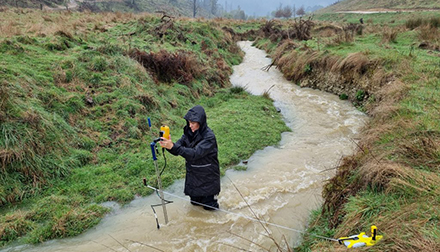
Corina Stebbings, Envirolink Hydrologist, gauging the waterflow in the creek below the harvested area.
A seven-year forestry study looking at the impact of sediment in rivers from harvesting and earthworks has entered its fifth year. The NZ$2.7 million study is jointly funded by the New Zealand Ministry for Primary Industries through its Sustainable Food and Fibre Futures fund and OneFortyOne New Zealand Forests. Source: Timberbiz
The work is being done in two forested catchments located in OneFortyOne’s Donald Creek Forest near Tadmor in the Tasman district.
Jo Field, OneFortyOne’s Environment Manager, said the study compares sediment from a harvested area with a non-harvested area, exploring the effectiveness of forestry erosion sediment control measures as well as looking at opportunities to improve practice.
The study is being conducted in two forested catchments located in OneFortyOne’s Donald Creek Forest near Tadmor in the Tasman district. The comparative catchments are adjoining and of similar size, area, geology and topography, and planted in Pinus radiata of similar age.
“Before the study started, we researched suitable locations, and we landed on Donald Creek as it represents the soil type found in a significant portion of our forests the region.” Ms Field said. The long-term study works with Moutere gravels, which is a relatively stable soil type with a high clay content.
The sediment control practices focus on reducing sediment into streams from disturbed ground (through earthworks and harvesting) as well as measuring water turbidity, the amount of fine sediment on and in the streambeds, and collecting stream habitat, algae cover, invertebrate, and fish data.
Most sediment will be ‘delivered’ during storms, so the focus of the project is on collecting good-quality, storm-related suspended sediment data from the pre-harvest to the post-harvest period. The project will quantify how much sediment can be prevented from leaving a harvesting site using sediment control practices.
“The current phase of the study is measuring post-harvest sediment load changes and impacts using current best practice sediment control techniques, alongside freshwater monitoring data collected throughout the study,” Ms Field said.
“This year we reached a significant milestone for the project. We were able to analyse and compare the data from a catchment that has been recently harvested with data from the control (unharvested) catchment.
“Interim results show that sediment loads are higher in the post-harvest catchment than in the control catchment. This is expected for the post-harvest area as there are extensive earthworks associated with roads and landings and it no longer has the tree canopy to reduce the impact of rain on the soils and stream, however the groundcover vegetation does develop rapidly. Importantly, the higher sediment loads in the stream appear to be from in-channel processes and not so much from the harvested area.
“Despite the sediment loads being higher after harvesting, there has been no quantitative or anecdotal evidence to suggest any impact on water quality or habitat in the Tadmor River downstream.
“This is a valuable opportunity to test the performance of current and new in-forest sediment management techniques – and we are grateful to work alongside Cawthron Institute, Envirolink, Manaaki Whenua – Landcare Research as well as the Ministry for Primary Industries. This is important work, which we’ll be able to share widely with the forestry sector and other stakeholders.”
For more information, watch: www.ruraldelivery.net.nz/posts/OneFortyOne-Forest-Management





